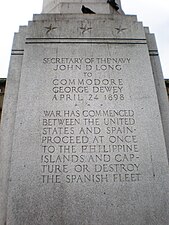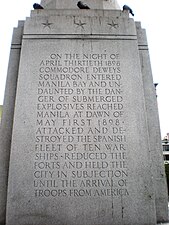 The Goddess of Victory statue by Robert Ingersoll Aitken atop the Dewey Monument (2010) | |
 | |
| 37°47′17″N122°24′27″W / 37.78795°N 122.40755°W | |
| Location | Union Square San Francisco, U.S. |
|---|---|
| Designer | Robert Ingersoll Aitken, sculptor Newton Tharp, architect |
| Width | 5 ft (1.5 m) |
| Height | 85 ft (25.9 m) |
| Beginning date | 1901 |
| Completion date | 1903 |
| Dedicated to | Admiral George Dewey |

The Dewey Monument is a memorial statue by Robert Ingersoll Aitken in San Francisco, California, located at the center of Union Square. Union Square is bounded by Geary, Powell, Post and Stockton Streets. The monument is dedicated to Admiral George Dewey and commemorates his victory in the Battle of Manila Bay during the Spanish–American War. Work on the monument began in 1901 and it was dedicated in 1903.



